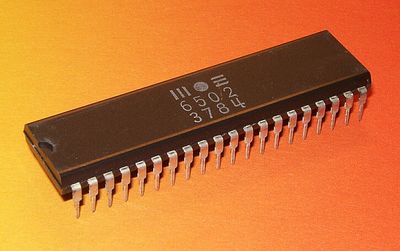Difference between revisions of "6502"
Chris Tyler (talk | contribs) (→Memory) |
Chris Tyler (talk | contribs) |
||
| Line 1: | Line 1: | ||
| − | [[Category:SPO600]][[Category:Computer Architecture]][[Category:Assembly Language]]The MOS Technologies 6502 processor was introduced in the mid-1970s to fill the need for a affordable general-purpose CPU. Its low cost (US$25 at introduction, less than C$0.89 now) was less than one-sixth of competing CPUs, and it had very simple circuitry requirements which made it simple and inexpensive to incorporate it into products. It was therefore used in many home and personal computers, such as the Apple II; the Commodore PET, Vic-20, and C64; the Atari 400 and 800; the BBC Micro; and games such as the Nintendo Entertainment System (NES). | + | [[Category:SPO600]][[Category:Computer Architecture]][[Category:Assembly Language]][[Image:MOS_6502_1.jpg|thumb|400px|right|The MOS 6502 processor. Image credit: Christian Bassow - [https://creativecommons.org/licenses/by-sa/4.0) CC-BY-SA 4.0] ]]The MOS Technologies 6502 processor was introduced in the mid-1970s to fill the need for a affordable general-purpose CPU. Its low cost (US$25 at introduction, less than C$0.89 now) was less than one-sixth of competing CPUs, and it had very simple circuitry requirements which made it simple and inexpensive to incorporate it into products. It was therefore used in many home and personal computers, such as the Apple II; the Commodore PET, Vic-20, and C64; the Atari 400 and 800; the BBC Micro; and games such as the Nintendo Entertainment System (NES). |
== Memory == | == Memory == | ||
Revision as of 15:16, 9 January 2020

Memory
The 6502 is an 8-bit processor with a 16-bit address bus. It is therefore able to access 64 kilobytes (216 bytes). Since each 16-bit address is comprised of two 8-bit bytes, memory can be viewed as 256 pages of 256 bytes each.
Each pointer in memory is stored in two consecutive memory locations, with the lowest-value byte stored first; this is known as Little Endian order. Thus, a pointer at memory location $0010, which points to memory location $ABCD, would be stored like this:
Memory $0010: $CD Memory $0011: $AB
Some pages have special, pre-defined purposes:
| Page | Name | Starting address | Ending address | Purpose |
|---|---|---|---|---|
| 00 | Zero Page | $0000 | $00FF | Variables requiring fast access |
| 01 | Stack | $0100 | $01FF | Values are pushed to, and pulled (popped) from, this region in first-in last-out (FIFO) order. The stack descends as it is used - more recently-pushed values are stored at lower addresses than older values. The stack wraps around, so if more than 256 bytes are pushed, the oldest values will be overwritten. |
| FF | Vector Table | $FF00 | $FFFF | The last 6 bytes of this page contain the three 2-byte addresses. $FE contains a pointer to code which is run when an interrupt request is received; $FC contains a pointer to code which is run when the CPU is reset (including when it is first started); and $FA contains a pointer to code which is run when a non-maskable interrupt (NMI) is received. |
In addition, each system built using the 6502 would have hardware devices, such as the video system, keyboard, and communication interfaces, occupying a portion of the address space.
Registers
There are three general-purpose registers:
- Accumulator (A) - the main register for math operations.
- X Index (X) - a register which can be used for limited math operations as well as indexed addressing modes, where an index value is added to a base address for memory operations.
- Y Index (Y) - a register similar to the X register. Some index operations may only be performed with a specific index register (X or Y, but not interchangeably).
There are also three special-purpose registers:
- Program Counter (PC) - a pointer to the currently-executing instruction in memory.
- Stack Pointer (S or SP) - a pointer to the current position in the stack
- Processor Status (P) - a collection of bits which indicate or control aspects of the processor mode and status:
- C - Carry - Used to indicate a carry or borrow during addition/subtraction
- Z - Zero flag - indicates that an operation produced a zero or equal result
- I - Interrupt disable
- D - Decimal mode - bytes are interpreted as two-digit decimal values instead of 8-bit binary values when doing math
- B - Break - Indicates a software interrupt rather than a hardware interrupt has occurred
- V - Overflow - Set when a math operation overflows a one-byte result
- S - Negative Sign - set when an operation produces a negative result
Instruction Set
The 6502 instruction set consist of a number of single-byte opcodes, each of which is followed by 0, 1, or 2 bytes of arguments. Each opcode corresponded to an instruction, which consists of an operation and an addressing mode. 6502 Assembly Language uses 3-letter menomics to specify the operation, and argument syntax to specify the addressing mode. For example:
LDA #$05 ; load the accumulator with the number 5 LDA $05 ; load the accumulator with the contents of memory location 5 (in the zero page) LDA $f005 ; load the accumulator with the contents of memory location $f005
See the references (below) for the full details of the 6502 instruction set.
6502 Emulator
Since 6502 systems are no longer very common, a web-based 6502 Emulator is available for assembling, testing, and debugging 6502 Assembly code.